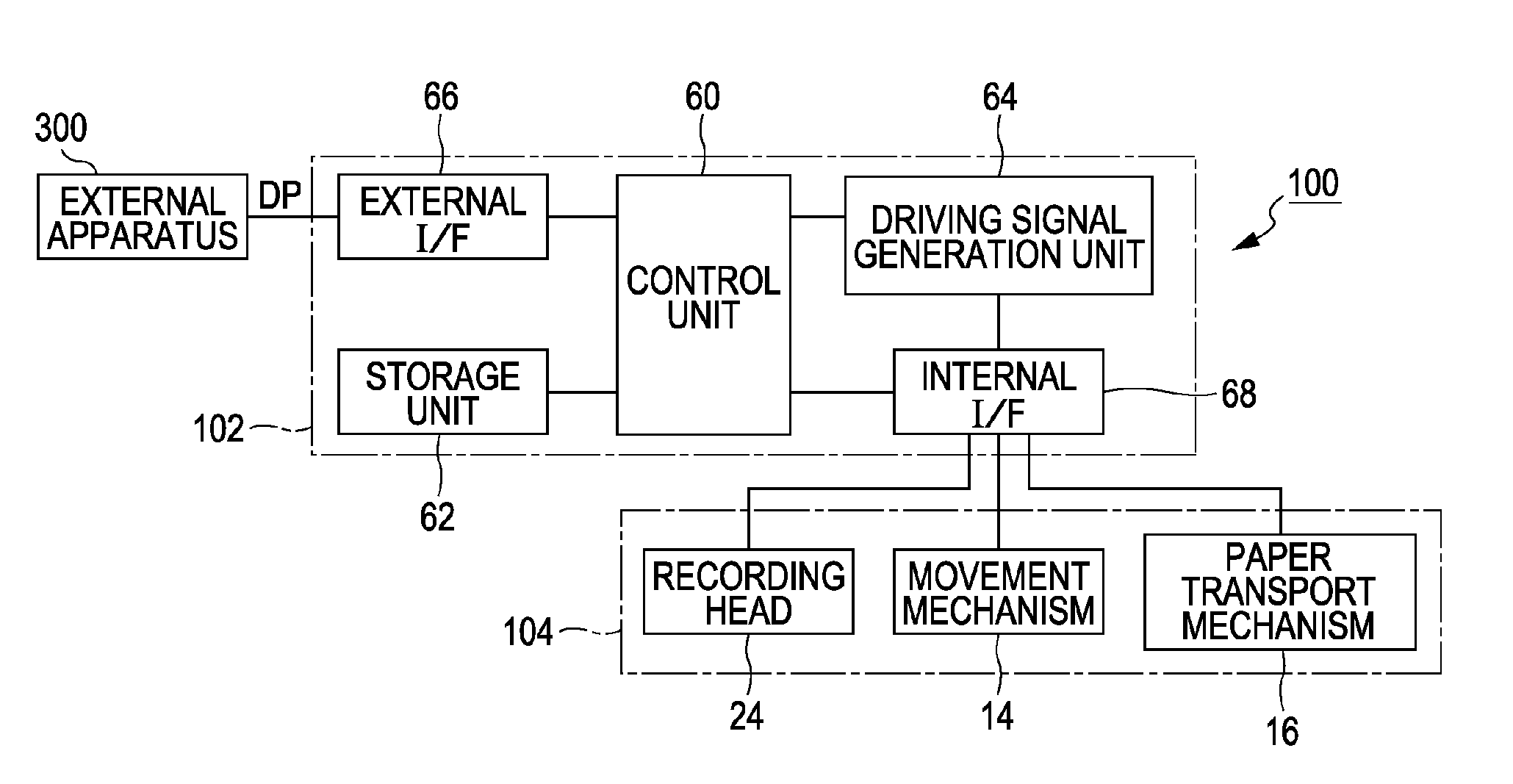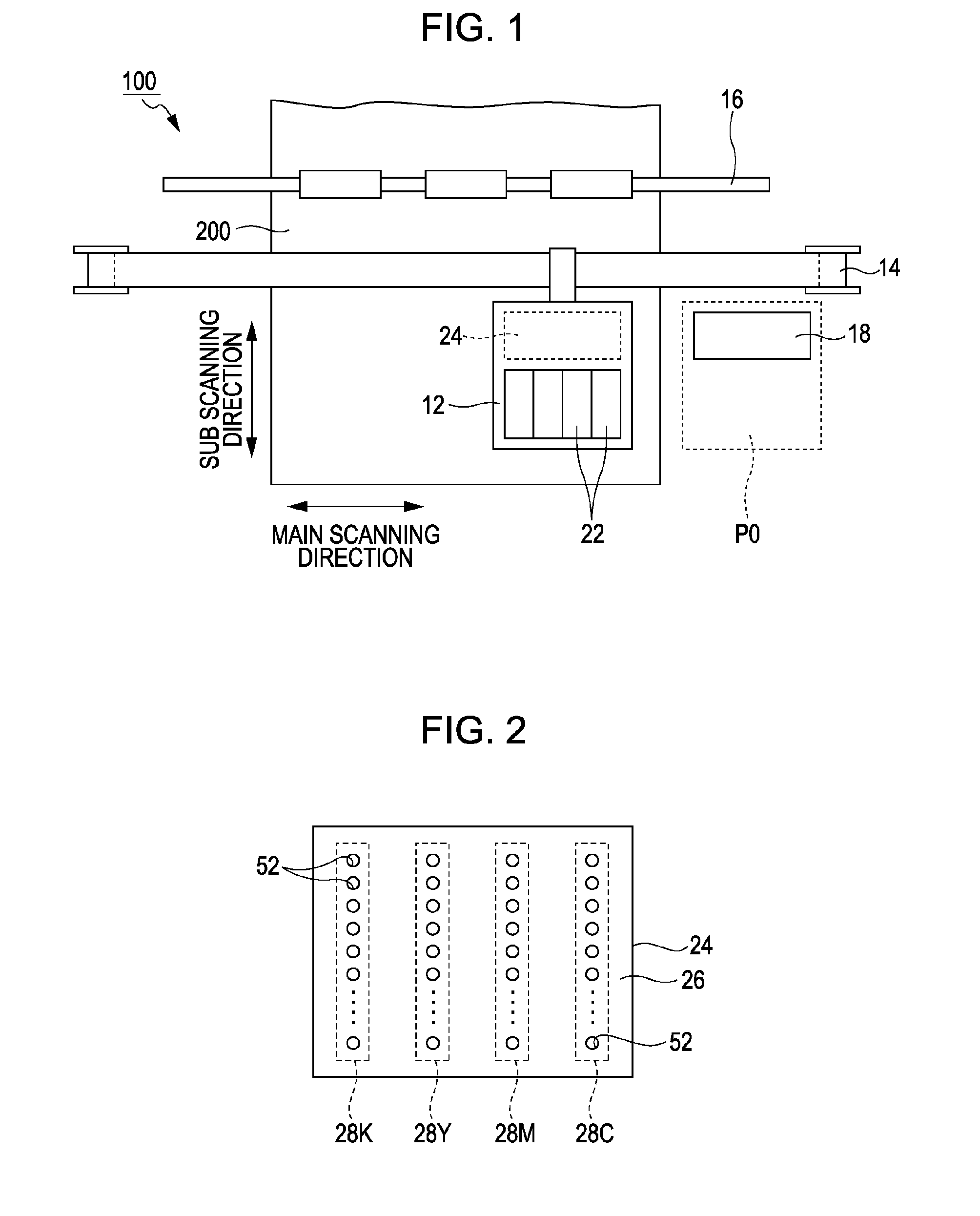Liquid ejecting apparatus and control method thereof
a liquid ejecting and liquid technology, applied in the direction of printing, other printing apparatus, etc., can solve the problems of insufficient discharge of thickened liquid components, difficult to accurately detect the viscosity of ink components that have not thickened within, and the inability to completely rectify the thickening of ink due to evaporation of solvent, etc., to achieve the effect of reducing residual vibration
- Summary
- Abstract
- Description
- Claims
- Application Information
AI Technical Summary
Benefits of technology
Problems solved by technology
Method used
Image
Examples
first embodiment
[0036]FIG. 1 is a partial schematic diagram illustrating an ink jet printing apparatus 100 according to a first embodiment of the invention. The printing apparatus 100 is a liquid ejecting apparatus that ejects ink droplets onto recording paper 200, and includes a carriage 12, a movement mechanism 14, and a paper transport mechanism 16.
[0037]Ink cartridges 22 and a recording head 24 are mounted in the carriage 12. The ink cartridges 22 are receptacles that hold ink (liquid) to be ejected onto the recording paper 200. The recording head 24 functions as a liquid ejecting head that ejects the ink held in the ink cartridges 22 onto the recording paper 200. Note that a configuration in which the ink cartridges 22 are fixed to a housing (not shown) of the printing apparatus 100 and the ink is supplied to the recording head 24 therefrom can also be employed.
[0038]FIG. 2 is a plan view of an ejection surface 26 of the recording head 24 that faces the recording paper 200. As shown in FIG. 2,...
second embodiment
[0061]A second embodiment of the invention will be described next. Note that for elements in the following embodiments that have the same effects, functions, and so on as those in the first embodiment, the reference numerals referred to in the above descriptions will be applied, and detailed descriptions thereof will be omitted as appropriate.
[0062]FIG. 14 is an example of a flow of operations through which the control unit 60 according to the second embodiment corrects the driving signal COM in the adjustment period RFL. In the second embodiment, a first flushing operation (step S201) and a second flushing operation (step S206) are executed. An amount of ink based on the result of the first flushing operation is ejected in the second flushing operation.
[0063]When the printing period RDR ends and the adjustment period RFL begins, the control unit 60 connects the piezoelectric element 45 to the driving circuit 322 by controlling the switching circuit 326, and furthermore supplies the...
third embodiment
[0065]FIG. 16 is an example of a flow of operations through which the control unit 60 according to a third embodiment corrects the driving signal COM in the adjustment period RFL. As in step S201 to step S204 in the second embodiment, when the printing period RDR ends and the adjustment period RFL starts, the control unit 60 executes the first flushing operation, and calculates a characteristic value Cvc in the current printing period RDR based on the residual vibrations Rv produced by the Mth ejection driving (step S301 to step S304). The control unit 60 determines the number N of ejection drivings in the second flushing operation in accordance with a difference Δ (Δ=Cvc−Cvp) between the current characteristic value Cvc and a characteristic value Cvp calculated after the flushing operation (the first flushing operation or the second flushing operation) performed in the previous adjustment period RFL (step S305). Specifically, in the case where the difference Δ exceeds a threshold T...
PUM
 Login to View More
Login to View More Abstract
Description
Claims
Application Information
 Login to View More
Login to View More - R&D
- Intellectual Property
- Life Sciences
- Materials
- Tech Scout
- Unparalleled Data Quality
- Higher Quality Content
- 60% Fewer Hallucinations
Browse by: Latest US Patents, China's latest patents, Technical Efficacy Thesaurus, Application Domain, Technology Topic, Popular Technical Reports.
© 2025 PatSnap. All rights reserved.Legal|Privacy policy|Modern Slavery Act Transparency Statement|Sitemap|About US| Contact US: help@patsnap.com



